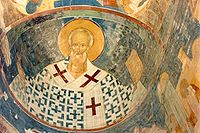
Ferapontov Monastery
Encyclopedia

Vologda Oblast
Vologda Oblast is a federal subject of Russia . Its administrative center is Vologda. The largest city is Cherepovets.Vologda Oblast is rich in historic monuments, such as the magnificent Kirillo-Belozersky Monastery, Ferapontov Convent , medieval towns of Velikiy Ustyug and Belozersk, baroque...
of Russia
Russia
Russia or , officially known as both Russia and the Russian Federation , is a country in northern Eurasia. It is a federal semi-presidential republic, comprising 83 federal subjects...
, is considered one of the purest examples of Russian medieval art
Russian architecture
Russian architecture follows a tradition whose roots were established in the Eastern Slavic state of Kievan Rus'. After the fall of Kiev, Russian architectural history continued in the principalities of Vladimir-Suzdal, Novgorod, the succeeding states of the Tsardom of Russia, the Russian Empire,...
, a reason given by UNESCO
UNESCO
The United Nations Educational, Scientific and Cultural Organization is a specialized agency of the United Nations...
for its inscription on the World Heritage List.
The monastery was founded by Saint Ferapont in 1398 in the inhospitable Russian North, to the east from the Kirillo-Belozersky Monastery
Kirillo-Belozersky Monastery
Kirillo-Belozersky Monastery , loosely translated in English as the St. Cyril-Belozersk Monastery, used to be the largest monastery of Northern Russia. The monastery was dedicated to the Feast of the Dormition of the Theotokos, for which cause it was sometimes referred to as the Dormition Monastery...
, named after his fellow monk, Saint Kirill of Beloozero. The fame of the monastery started to spread under Kirill's disciple, Saint Martinian, who was to become a father superior of the Troitse-Sergiyeva Lavra
Troitse-Sergiyeva Lavra
The Trinity Lavra of St. Sergius is the most important Russian monastery and the spiritual centre of the Russian Orthodox Church. The monastery is situated in the town of Sergiyev Posad, about 70 km to the north-east from Moscow by the road leading to Yaroslavl, and currently is home to...
in 1447.
Even after Martinian's death, his monastery was protected and favoured by members of Ivan III's family. The most ancient structure, the Cathedral of Nativity of the Virgin (1490), was built in brick by the masters of Rostov
Rostov
Rostov is a town in Yaroslavl Oblast, Russia, one of the oldest in the country and a tourist center of the Golden Ring. It is located on the shores of Lake Nero, northeast of Moscow. Population:...
. This edifice is the best preserved of three sister cathedrals erected in the 1490s in the Russian North. All the interior walls are covered with invaluable fresco
Fresco
Fresco is any of several related mural painting types, executed on plaster on walls or ceilings. The word fresco comes from the Greek word affresca which derives from the Latin word for "fresh". Frescoes first developed in the ancient world and continued to be popular through the Renaissance...
es by the great medieval painter Dionisius
Dionisius
Dionisius was acknowledged as a head of the Moscow school of icon painters at the turn of the 15th and 16th centuries. His style of painting is sometimes termed "the Muscovite mannerism"....
. This is the last survived Russian medieval church with fully painted walls.
During the 1530s, they added a treasury, a refectory, and the unique Annunciation church surmounted by a belfry. At that time the monastery enjoyed special privileges conferred upon it by Ivan the Terrible, and possessed some 60 villages in the vicinity. The tsar himself frequently visited the monastery as a pilgrim.
In the Time of Troubles
Time of Troubles
The Time of Troubles was a period of Russian history comprising the years of interregnum between the death of the last Russian Tsar of the Rurik Dynasty, Feodor Ivanovich, in 1598, and the establishment of the Romanov Dynasty in 1613. In 1601-1603, Russia suffered a famine that killed one-third...
, the monastery was ravaged by the Poles
Poles
thumb|right|180px|The state flag of [[Poland]] as used by Polish government and diplomatic authoritiesThe Polish people, or Poles , are a nation indigenous to Poland. They are united by the Polish language, which belongs to the historical Lechitic subgroup of West Slavic languages of Central Europe...
. During its recovery the last buildings — the tent-like church of Saint Martinian (1641), a two-tented barbican church (1650), and a bell-tower (1680) — were added to the complex. The belfry clocks (1638) are said to be the oldest in Russia.
As the monastery gradually lost its religious importance, it was being turned into a place of exile for distinguished clerics, such as the Patriarch Nikon
Patriarch Nikon
Nikon , born Nikita Minin , was the seventh patriarch of the Russian Orthodox Church...
. It was abolished by Emperor Paul in 1798, reinstituted as a convent in 1904, closed by the Bolsheviks twenty years later, and turned into a museum in 1975. The museum constitutes a part of the Russky Sever
Russky Sever National Park
Russky Sever National Park is the national park in the north of Russia, located in Kirillovsky District of Vologda Oblast. It was established on March 20, 1992. The name of the park means Russian North in Russian...
(Russian North) National Park since 1991.
External links
- All the murals of the Ferapontov Monastery online
- Official web page of the monastery
- Ferapontovo: Medieval Treasure in the Russian North William C. Brumfield, April 6, 2010, Russia Now, article with a photos slideshow.

